The Nonpartisan Leader Newspaper, February 2, 1920, Page 3
You have reached the hourly page view limit. Unlock higher limit to our entire archive!
Subscribers enjoy higher page view limit, downloads, and exclusive features.
L In the interest _of a square deal for the farmers ° VOL. 10, NO. & “ST. PAUL, MINNESOTA, FEBRUARY 2, 1920 risein Teader Official thazine of the National Nonpartisan League A magazine .that dares to print the truth WHOLE NUMBER 228 vGettin’g Rid of the School Bdok Trust - ‘North Dakota Investigates F easibility of State Publication— W hat California and Kansas Have Done ' Bismarck Bureau, Nonpartisan Leader. H]RELIMINARY investigations into the advisability of state publication ‘of school books have been made by the North Dakota state board of admin- | istration. A request for such infor- > mation was made by the last regular session of the legislature and before the next as- sembly meets an exhaustive report will be at hand for action, if desired. Advocates of state publication see in it a number of advantages, any one of which would be a’ decid- ing factor: : s 1. Lower cost. 2. Better books, because they can contain many special references to the pupil’s own state. 3. Elimination of school book interests from state and county politics. 4. Keeping within the state money which now goes to eastern concerns. As to lower cost the favorable experience of Cali- fornia and Kansas can be ¢ited. The Kansas state printer, Imri Zumwalt, for instance, sends the North Dakota board the following figures showing the sav- ings made in his state on different books: Former price or State Book - : price elsewhere price Reading ichart. . o e davies eavne $12.00 1.10 Kandas History .... . .66 1.25 Elementary History .58 50 Fifth Reader ...... 44 .29 Elementary Arithmet; 40 .28 Advanced Arithmetic . .58 .39 Geometry ........ A, 1.07 70 English Book I. .o 42 23 English Book II. .56 34 Agriculture ........ 3's . '.88 : .35 Primary Physiology ..... s e .30 22 Advanced PhysioloZY weuveesvens... 50 35 These books have been supplied to schools of the state in large quantities, ranging from 20,000 for the Advanced Physiology to 168,985 for the Ele- THEY CAN'T HOOK ON BEHIND mentary Arithmetie, and Mr. Zumwalt puts the net saving on the number sold since the enactment of the law in 1915 at $294,094.16. ; In California, where state printing has been practiced since 1883, the margins between state selling prices and those of book companies are much wider. Its department of education places the net saving, with every possible cost considered, at better than 25 per cent. .- California supplies textbooks to the children free, whereas Kansas charges enough to cover costs. The California books are so cheap, however, that the state has a large income from sales to private schools within the state and sales to parents who want duplicate books for the children to use at home. cr : TEXTBOOKS SHOULD DEAL MORE WITH LOCAL CONDITIONS Almost all books used by school children can give special reference to local conditions. State -geography, state history, state literature and state government can be given attention not possible in books intended for general use throughout the United States. Examples and illustrations can be drawn from familiar facts. The child thus, can learn more about the environment in which he will probably grow up and live while he is getting a general education. At the same time there is nothing to hinder the state textbook commission from choosing the best outside material the world has. Few people outside of active old-party politics probably realize the pressure which the book com- panies bring to bear upon county superintendents of education and other officers charged with the duty of selecting school books. The insider doesn’t WAI'T Forz ask whether a superintendent is incorruptible, but whether he is “American Book,” “Ginn & Co.,” or any one of a half dozen other book corporations that may be specializing on the particular state. Pressure is also brought on teachers to get them to demand certain books. Under the prevailing system the choice of books, therefore, does not de- pend on merit,,as is claimed, but on political power of the respective book companies—certainly not a worthy educational standard. The book companies thus lend considerable support to country ring government which would be eliminated with state publishing. ‘ With regard to this political factor, the Cali- fornia department of education says in one of its reports: “The great publishing houses' had agents circu- lating in every part of the land, whose religion it was to everlastingly damn the whole idea of state publication. P “The leading educators almost universally fol- lowed suit. Institutes, clubs and associations con- demned. No educational gathering was complete that did not take a fall out of the state textbooks. Never did any one have a good word to say of them in public. They were an impersonal sort of thing, like the weather, that any one could criticize and abuse without fear of unpleasant consequences. “Doubtless at this time (1883-1903) any books whatever that could have been printed by the state would have met the same fate. Yet it is worth remarking that the people of the state who do the voting in the legislature and at the polls have never failed to uphold the California plan by over- whelming majorities whenever an opportunity has come to them, even down to the present day.” AN AUTOM OBILE! l WISH [ HAp ONE OF THeM NONPARTISAN EAGUE AUTOMOBI e e







